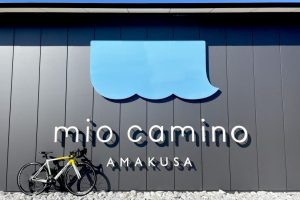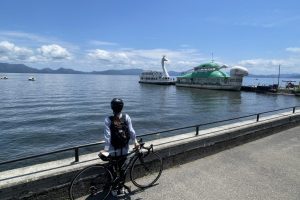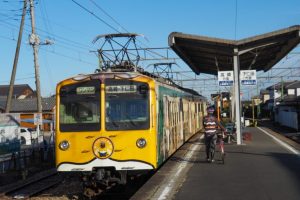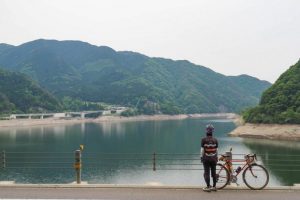Starting from JR Maebashi Station, we will introduce a clockwise round-the-clock route around Mt Akagi. If you are confident in your legs, you can ride the route in one day, or if you want to take your time while sightseeing, you can stay overnight at Oigami Onsen hot springs.
The routes we will show you are long rides through mountainous areas, so be sure to bring food, a phone charger, and a light before you go!
Contents
- Starting at JR Maebashi Station (Maebashi City)
- Shiroi-shuku and Roadside Station Komochi (Shibukawa City)
- Akagi Countryside Manjuu (Shibukawa City), perfect for refueling
- A big break at Roadside Station Agream Showa (Showa Village)
- Nango-no-Magariya (Numata City) with its splendid kayabuki roof
- Take a break at Akagi Tofu Sumireya (Kiryu City)
- Healing from the satoyama scenery
- Let’s take a walk around Omama Station (Midori-shi)
- A photo spot where you can see the entire Mt.Akagi
- Visit Sannatai Shrine (Maebashi City)
- Cycle Train to Chuo Maebashi Station
- If you come by car, start at Roadside Station
- Course Introduction
- Summary
Starting at JR Maebashi Station (Maebashi City)

There is a Giant Store Maebashi near the starting point, JR Maebashi Station, where road and cross bikes can be rented.
You can also rent e-bikes at AKAGI e-Bike, operated by Maebashi Tourism Convention Association.

Ride north through the city and when you reach Hirose River, cross the bridge and turn left. Ride along the riverside road, passing between Maebashi Central Kids Amusement Runa Park and Rinko-kaku, and reach Prefectural Route 10.
Rinko-kaku is a modern Japanese-style wooden building and a nationally designated Important Cultural Property. It is not only a sightseeing facility with free admission, but is also used as a venue for Japanese tea ceremonies, exhibitions, events, and as a filming location for music videos.

Heading north on Tone River Cycling Road
Cross Tone River at Chuo Ohashi Bridge and enter Tone River Cycling Road.
The roadway of Chuo Ohashi Bridge is closed to bicycles, so if you wish to cross the bridge, go through the pedestrian-bicycle bridge.

Once on Tone River Cycling Road, you will see the magnificent Gunma prefectural office building on the other side of the river.

There are several cherry blossom trees along the bike path, which will be at their best in late March, so please come and ride when the cherry blossoms are at their best.

From an open area along the way, you can clearly see Mt.Akagi.


At about 10km from the start, you will find Roadside Station Yoshiooka Onsen (hot spring).
It is a good resting point with a shop, a restaurant, and a free footbath. A one-day hot spring center, Rivertopia Yoshioka, is adjacent to the station.

Further north, the cycling road ends at Taisho Bridge, where National Route 353 and the JR railroad bridge come into view.
Exit to Route 17 and turn left just after crossing Azuma Shinbashi Bridge and enter a narrow alley.
Shiroi-shuku and Roadside Station Komochi (Shibukawa City)

Cycling through Shiroi-shuku, there is a weir about 820m long in the center, dotted with eight tsurube wells and stone structures. Usually in late April or early May, the double-flowered cherry trees are in bloom and beautiful.

Buildings in the dozo style still remain, and visitors can feel the townscape from the Edo period. There is also a café in a renovated old private house, so if you are interested, stop by.
Roadside Station Komochi is located between the quiet Shiroi-juku and National Route 17.
Because of its location along National Route 17, the roadside station is always crowded.

It is about 20km from the starting point. After this point, you will enter a highland area where there are few restaurants, so you might want to eat something light. The roadside station is a fun place to take a break and enjoy the famous Katsu-don (pork cutlet bowl), Akagi beef menchi (Minced meat cutlet), Akagi beef and potato croquettes, and more.
Behind the roadside station is Kawazu Cherry Blossom Hill Shiroi, which is at its best around mid-March.
Akagi Countryside Manjuu (Shibukawa City), perfect for refueling
After crossing National Route 17, continue all the way down the hill to Joetsu Line at the end of Tone River.
Heading north along Joetsu Line, you will arrive at Shikishima Station. At Arai Shoten in front of the station, purchase the famous Akagi Countryside Manjuu.
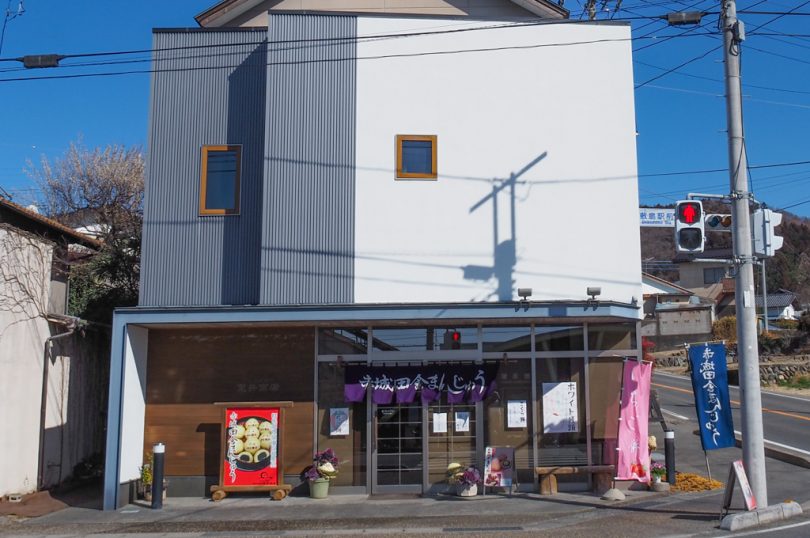
The small, not-too-sweet red bean paste is excellent and perfect for a supply meal. Other popular items include seasonal fruit rice cakes and dorayaki. In summer, they even sell ice cream dorayaki!

Riding on a wide-area farm road with a great view
From the front of Shikishima Station, we turn onto Prefectural Route 157 and finally begin the full-scale climb.
Riding along Numao River, the piers of Kanetsu Expressway come into view in front of you. Combined with the towering quay walls along the river, it is a powerful sight.

As we climbed up the winding road, the view opened up and Kanetsu Expressway, which we had just passed under, could be seen below us. Before we knew it, we realized that we had climbed quite a bit. Behind Kanetsu Expressway, Mt. Haruna and Mt. Asama.

After passing through Showa-no-mori Golf Course, the scenery changes to fields spreading out on both sides.

From Matsunoki Viewpoint, located in an open area, you can enjoy the scenery of the four seasons.


A big break at Roadside Station Agream Showa (Showa Village)
After continuing along Tone Numata Bokyo Line and going down a straight road for a short while, you will arrive at Roadside Station Agream Showa.


It is a large roadside station with an agricultural produce stand, a natural hot spring footbath, and a restaurant, and the crepes made from fresh vegetables and buckwheat flour from Showa Village are popular at LACTUCA restaurant.

Other shops include Muranoka Coffee, which opened in 2022, serving authentic coffee made from beans from a popular coffee roasting store in Gunma Prefecture, and sweets made from strawberries from the company’s own farm. The photo shows Special Strawberry Parfait and Strawberry Parfait (sold seasonally from March to May, subject to change depending on growing conditions).

The natural hot spring footbath facility is also an indoor type that can be used even if it rains, and it is the best place to soak in the footbath and lie down on the ground.
The roadside station also rents out cross bikes, e-bikes, and junior cycles.
After a leisurely rest, head north on the Tone Numata Bokyo Line.
The vast open land can be ridden because Gunma Prefecture is home to some of the best river terraces in Japan.


From Bokyo Line around Kainose Viewpoint, you can see Mt. Tanigawa and Mt.Hotaka. The magnificent view of the mountains is sure to impress.

In the summer, the fields are filled with vegetables and the scenery is transformed into lush green fields.

The road goes downhill to Katashinagawa and leaves the Mochigo Line at the Wagumi-Ohashi Bridge crossing.
If you want to spend more time on the tour in two days, you may choose to go north and stay overnight at Roujin Onsen (hot spring).
If you want to do the whole tour in one day, go for the other half! If you want to tour the area in a day, you can do the other half of the route.
Nango-no-Magariya (Numata City) with its splendid kayabuki roof
Let’s stop by Nango-no-Magariya (former Suzuki family residence), which is designated as an important cultural asset by Numata City.

This is the former house of the Suzuki family, who once came to the village as priests to build Kumano Shrine in this area and served as the head of the family for generations. Visitors can take a rest on the porch of the magariya-minka (traditional Japanese-style house with a kayabuki roof) and soak away their fatigue in the footbath. There is also a one-day hot spring, a restaurant, and a direct sales shop for agricultural and forestry products.

Ride calmly along the route over the mountains
After passing the Nango-no-Magariya, prepare a drink or something as there will be no shops for a while.
You will be driving along Prefectural Route 62 Numata-Omama line. Unlike the wide-area farm road area of Bokyo line in the first half of the route, this mountain road is lined with many trees. The road surface will be rough, so be careful.

The road peaks at the border between Numata City and Kiryu City, and then begins a long descent.
There are several long tunnels in the middle of the hill, so be sure to turn on your front and rear lights.
From the top of Iwashita Bridge, you can see the view of Kuyryu Mountain area.

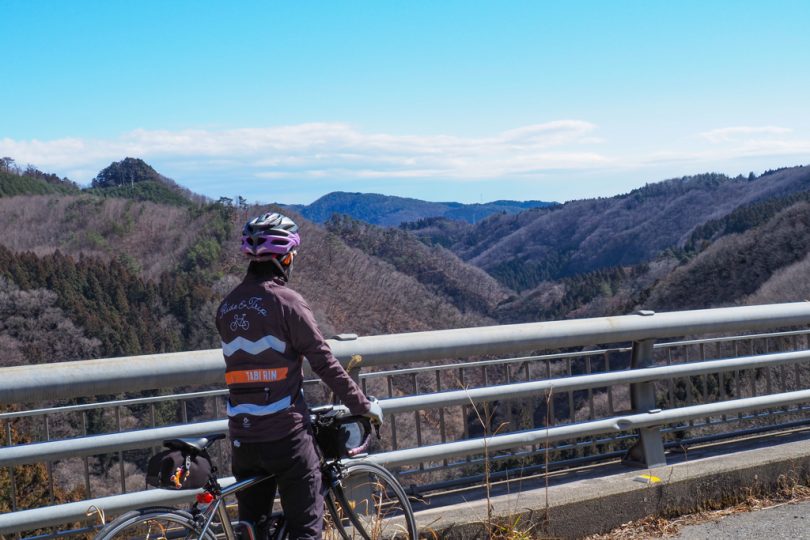
There are almost no shops from Numata City up the hill until you enter Kiryu City, so when you see a log house restaurant in front of you, it is impossible not to enter. The house restaurant “Logtei” is popular for its delicious pasta, pizza, and gratin.


Take a break at Akagi Tofu Sumireya (Kiryu City)
The former Kurohone Village (now Kiryu City) was the first village in Japan to declare itself a “water source village”. Stop by Akagi Tofu Sumireya, where you can enjoy the delicious taste of soybeans made with delicious Akagi fresh water. You can enjoy cheese tofu and tofu ice cream served as dessert.

Healing from the satoyama scenery

Ride along Kiyomizu Tusuji (Azalea) Road in Kurohone-cho to Jokanji Temple.

The bell on the temple grounds was made by a famous foundryman in Sano, Shimono-kuni. It is considered to be a bell of high artistic value, with a seated image of the Holy Kannon (Goddess of Mercy). You are free to toll the bell, so you should do so to commemorate the event.
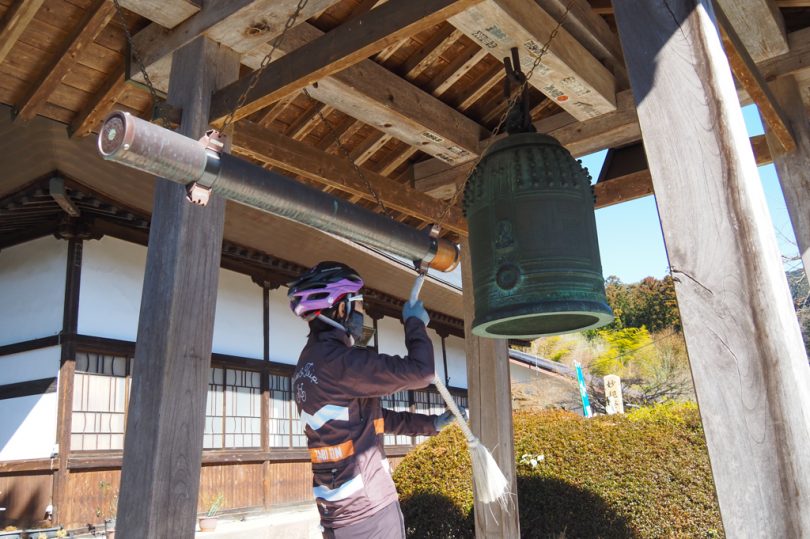

After exiting National Route 122, immediately enter Prefectural Route 257.
At Mizunuma Station on the way to Prefectural Route 257, 300 cherry trees of nine varieties are planted, and they bloom one after another starting with Kawazu cherry blossoms in mid-March.
Many people visit the station to take pictures of the railroad and cherry blossoms. (The best time to see someiyoshino cherry trees is in early April.)

Prefectural Route 257 is a little rough, but there are few cars on the road, and Watarase River and Watarase Gorge Railway can be seen through the trees.

Let’s take a walk around Omama Station (Midori-shi)
After passing through a small tunnel, you will come to Kifune Shrine.
This shrine, beloved by the local people, was originally built in 956 to enshrine a spirit from Kifune Shrine in Kyoto to pray for rain and a bountiful harvest. It is also famous as one of Gunma’s most popular power spots. The shrine is also famous for its “mizu-mikuji” (water paper fortune), which is interesting because the characters come to life when the shrine is wet with water.
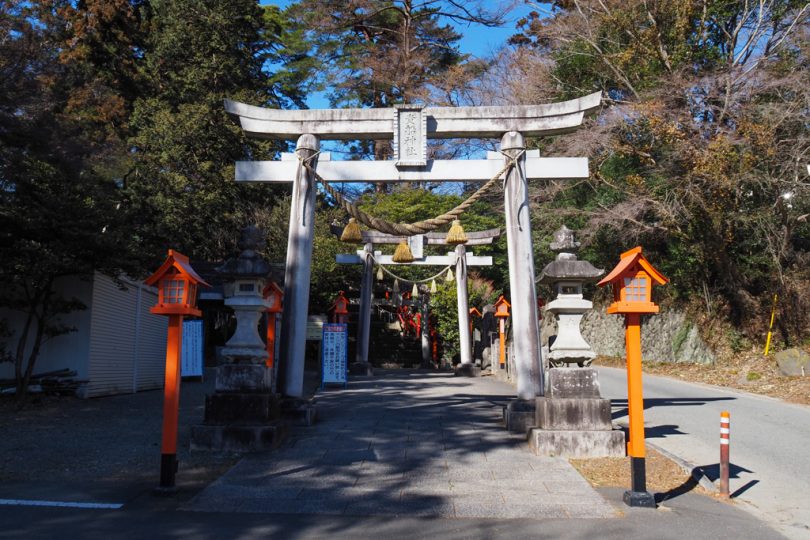

Cross Watarase River and ride along Watarase Gorge Railway. This area is called Takatsudo Gorge and is a popular spot for beautiful fresh greenery and autumn foliage. The view from the Hanetaki Bridge over the river is praised as “Yabakei” of the Kanto area (original Yabakei is in Oita Prefecture).


The area around Omanma Station is lined with historical buildings such as Midori-shi Omanma Museum (Konodonto-kan) and Oka Naosaburo Shoten. A leisurely stroll around the area is recommended.
Next to the Omanma Station, a retired train car from the time of its opening is preserved and displayed, and you can also see the car parked at the station up close.

Oka Naosaburo Shoten, a soy sauce brewery that has been in business since the Edo period (1603-1868), sells a variety of soy sauce products, including a special soy sauce made from natural brewed soy sauce in wooden vats, a soy sauce for egg over rice, soy sauce spices in granulated form, and a spicy seasoning called SHOUYUSCO, all in pursuit of the possibilities of soy sauce.

The soy sauce soft-serve ice cream sold in the store is an addictive product with a slight soy sauce flavor and aroma. You can also enjoy other arrangements such as adding soy sauce to vanilla soft serve ice cream.

Enter Natinaol Route 353 and turn left before Gunma Insects Forest. Ride gently south.

Gokan Chicken Farm, located near River History and Folklore Museum and Zen Castle Ruins Park, sells freshly picked eggs and a variety of processed egg products.

Three kinds of puddings are particularly popular. “Chiyotama Pudding,” which is made with rich yolk of rare first-born eggs and thickened with fresh cream without caramel. The smooth pudding with a melt-in-your-mouth texture and the traditional firm custard pudding, each have their own fans.

Located near Zen Station on Jomo Dentetsu Line, Ota Shokudo is a homey restaurant that focuses on handmade dishes and is visited by many local fans at lunchtime. The turnover is fast, and it is wonderful to enter the restaurant without much waiting.

The restaurant has a good crowd, but its fried dishes are popular for their lightness. An odd local menu item is Katsu Curry Ramen. Lunch hours are until 2:00 p.m., so be sure to come early if you want to try it.

A photo spot where you can see the entire Mt.Akagi
Cross Jomo Electric Railway and go south. Cross Kasugawa River and go further south. Continue along the straight road, and when you look back at the hill at the end of the road, you will be impressed to see Mt. Akagi in full view.

If you are riding around Mt. Akagi, you will definitely want to take a commemorative photo here.

Visit the ancient tombs at Omuro Park (Maebashi City)
We arrived at Nihon Campac Omuro Park at the southernmost point of the route.
Omuro Kofun Tumulus Group is a highlight of the park and was the location for a JR TV commercial.
Naka-futago mound is the largest forward-rear mound in the Omuro Kofun Tumulus Group, and is surrounded by haniwa terra-cotta tombs, which make a big impact.

You can also enter the stone chamber of Mae-futago mound.


In late March and early April, cherry blossoms bloom in the park, making it a popular hidden cherry blossom viewing spot. Visitors can stroll around the park while enjoying the cherry blossoms.

Visit Sannatai Shrine (Maebashi City)
Moving west from Omuro Park, you will arrive at Sannatai Shrine.

The shrine is said to be beneficial for praying for easy delivery, but you can also visit the shrine for other charms to increase your luck and improve your business performance.

Cycle Train to Chuo Maebashi Station
From Ogo Station on Jomo Electric Railway, take the cycle train to Chuo Maebashi.

What is reassuring about this line on the southern foot side is that the cycle train allows you to bring your bicycle directly into the car without putting it in a wheeled bag! It is a great place to be able to ride a bike from the station you feel like riding.


Once you get off at Chuo-Maebashi Station, you can ride to JR Maebashi Station to reach the goal.

If you come by car, start at Roadside Station
If you are coming by car, we recommend that you use the Roadside Station Akagi-no-Megumi shown on the map and the new Roadside Station Mabashi Akagi, which will open on March 21st, 2023, to get around. After a long ride, it would be great to be able to go home after relieving your fatigue at one of the roadside station’s day-trip hot springs.
Course Introduction
▼Akagi Cycling Map
https://tabi-rin.com/archives/map/54957
▼Roadside Station Agream Showa
https://agream-showa.jp/
▼Nihon Campac Omuaro Park
https://www.maebashi-cvb.com/spot/1010
▼Santai Shrine
https://www.santai-jinja.jp/
▼Roadside Station Maebashi Akagi (scheduled to open March 21st, 2023)
https://maebashi-akagi.jp/
Summary
The round-the-mountain route of Mt. Akagi is a long route of about 120km, which is hard, but we hope you will enjoy the route you can run while consulting with your leg strength, referring to the sights along the way.
You can also come to the roadside station by car or take the cycle train to enjoy the tasty food and drink.
Written by Aya Kosone
Advertiser: Maebashi Tourism & Convention Association













